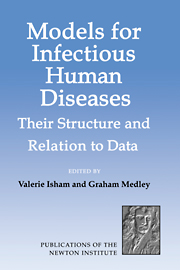Book contents
- Frontmatter
- Contents
- Introduction
- Participants
- Non-Participant Contributors
- Part 1 Transmissible diseases with long development times and vaccination strategies
- Part 2 Dynamics of immunity (development of disease within individuals)
- Evolutionary dynamics of HIV infections
- Statistical models for analysis of longitudinal, CD4 data
- Some mathematical and statistical issues in assessing the evidence for acquired immunity to schistosomiasis
- Virulence and transmissibility in P. falciparum malaria
- Invited Discussion
- Invited Discussion
- Invited Discussion
- Lifespan of human T lymphocytes
- Diversity and virulence thresholds in AIDS
- Statistical analysis of AZT effect on CD4 cell counts in HIV disease
- Modeling progression of HIV infection: staging and the Chicago MACS cohort
- The interpretation of immunoepidemiological data for helminth infections
- The distribution of malaria parasites in the mosquito vector: consequences for assessing infection intensity in the field
- When susceptible and infective human hosts are not equally attractive to mosquitoes: a generalisation of the Ross malaria model
- The dynamics of blood stage malaria: modelling strain specific and strain transcending immunity
- Part 3 Population heterogeneity (mixing)
- Part 4 Consequences of treatment interventions
- Part 5 Prediction
Invited Discussion
Published online by Cambridge University Press: 04 August 2010
- Frontmatter
- Contents
- Introduction
- Participants
- Non-Participant Contributors
- Part 1 Transmissible diseases with long development times and vaccination strategies
- Part 2 Dynamics of immunity (development of disease within individuals)
- Evolutionary dynamics of HIV infections
- Statistical models for analysis of longitudinal, CD4 data
- Some mathematical and statistical issues in assessing the evidence for acquired immunity to schistosomiasis
- Virulence and transmissibility in P. falciparum malaria
- Invited Discussion
- Invited Discussion
- Invited Discussion
- Lifespan of human T lymphocytes
- Diversity and virulence thresholds in AIDS
- Statistical analysis of AZT effect on CD4 cell counts in HIV disease
- Modeling progression of HIV infection: staging and the Chicago MACS cohort
- The interpretation of immunoepidemiological data for helminth infections
- The distribution of malaria parasites in the mosquito vector: consequences for assessing infection intensity in the field
- When susceptible and infective human hosts are not equally attractive to mosquitoes: a generalisation of the Ross malaria model
- The dynamics of blood stage malaria: modelling strain specific and strain transcending immunity
- Part 3 Population heterogeneity (mixing)
- Part 4 Consequences of treatment interventions
- Part 5 Prediction
Summary
There was fascinating dichotomy presented this morning by the papers of Nowak and Taylor. This dichotomy has been given several names during this meeting, and my favourite is the distinction between thought experiments to understand the processes that generate observed patterns, and the analysis of real experimental data. These two papers are essentially addressing the same subject: the pattern of CD4 counts over time, and it appears to me that both approaches would benefit from consideration of the other. On one hand, Taylor explains much of the variability in the observed counts as being derived from an underlying stochastic process, whereas it may well be due to a highly non-linear process changing on a time-scale faster than the sampling interval. On the other hand, Nowak does not use his model to produce predictions of CD4 numbers which may actually be testable by comparison with such data.
There is general problem here with the use of deterministic models, i.e. those that produce a single value or set of single value results for each time point without any measure of variability. Differential equations are an invaluable tool for mathematical descriptions of disease processes, but suffer from the fact that data-derived estimates are required for the processes embedded in the equation system, for example density dependent transmission. There are methods available for fitting equations directly to observations of the system over time, but these tend to regard the variability in data as some form of random error, and the fitting involves simple reduction of the average difference between observation and model.
- Type
- Chapter
- Information
- Models for Infectious Human DiseasesTheir Structure and Relation to Data, pp. 189 - 190Publisher: Cambridge University PressPrint publication year: 1996

